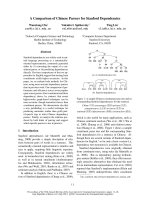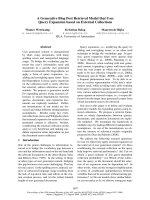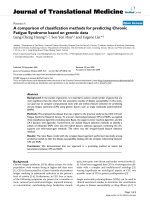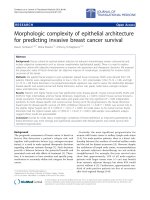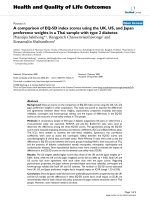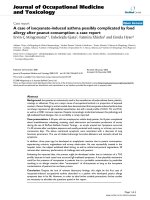báo cáo hóa học:" A comparison of classification methods for predicting Chronic Fatigue Syndrome based on genetic data" potx
Bạn đang xem bản rút gọn của tài liệu. Xem và tải ngay bản đầy đủ của tài liệu tại đây (222.07 KB, 8 trang )
BioMed Central
Page 1 of 8
(page number not for citation purposes)
Journal of Translational Medicine
Open Access
Research
A comparison of classification methods for predicting Chronic
Fatigue Syndrome based on genetic data
Lung-Cheng Huang
†1,2
, Sen-Yen Hsu
†3
and Eugene Lin*
4
Address:
1
Department of Psychiatry, National Taiwan University Hospital Yun-Lin Branch, Taiwan,
2
Graduate Institute of Medicine, Kaohsiung
Medical University, Kaohsiung, Taiwan,
3
Department of Psychiatry, Chi Mei Medical Center, Liouying, Tainan, Taiwan and
4
Vita Genomics, Inc,
7 Fl, No 6, Sec 1, Jung-Shing Road, Wugu Shiang, Taipei, Taiwan
Email: Lung-Cheng Huang - ; Sen-Yen Hsu - ; Eugene Lin* -
* Corresponding author †Equal contributors
Abstract
Background: In the studies of genomics, it is essential to select a small number of genes that are
more significant than the others for the association studies of disease susceptibility. In this work,
our goal was to compare computational tools with and without feature selection for predicting
chronic fatigue syndrome (CFS) using genetic factors such as single nucleotide polymorphisms
(SNPs).
Methods: We employed the dataset that was original to the previous study by the CDC Chronic
Fatigue Syndrome Research Group. To uncover relationships between CFS and SNPs, we applied
three classification algorithms including naive Bayes, the support vector machine algorithm, and the
C4.5 decision tree algorithm. Furthermore, we utilized feature selection methods to identify a
subset of influential SNPs. One was the hybrid feature selection approach combining the chi-
squared and information-gain methods. The other was the wrapper-based feature selection
method.
Results: The naive Bayes model with the wrapper-based approach performed maximally among
predictive models to infer the disease susceptibility dealing with the complex relationship between
CFS and SNPs.
Conclusion: We demonstrated that our approach is a promising method to assess the
associations between CFS and SNPs.
Background
Chronic fatigue syndrome (CFS) affects at least 3% of the
population, with women being at higher risk than men
[1]. CFS is characterized by at least 6 months of persistent
fatigue resulting in substantial reduction in the person's
level of activity [2-4]. Furthermore, in CFS, four or more
of the following symptoms are present for 6 months or
more: unusual post exertional fatigue, impaired memory
or concentration, unrefreshing sleep, headaches, muscle
pain, joint pain, sore throat and tender cervical nodes [2-
4]. It has been suggested that CFS is a heterogeneous dis-
order with a complex and multifactorial aetiology [3].
Among hypotheses on aetiological aspects of CFS, one
possible cause of CFS is genetic predisposition [5].
Single nucleotide polymorphisms (SNPs) can be used in
clinical association studies to determine the contribution
of genes to disease susceptibility or drug efficacy [6,7]. It
Published: 22 September 2009
Journal of Translational Medicine 2009, 7:81 doi:10.1186/1479-5876-7-81
Received: 23 June 2009
Accepted: 22 September 2009
This article is available from: />© 2009 Huang et al; licensee BioMed Central Ltd.
This is an Open Access article distributed under the terms of the Creative Commons Attribution License ( />),
which permits unrestricted use, distribution, and reproduction in any medium, provided the original work is properly cited.
Journal of Translational Medicine 2009, 7:81 />Page 2 of 8
(page number not for citation purposes)
has been reported that subjects with CFS were distin-
guished by SNP markers in candidate genes that were
involved in hypothalamic-pituitary-adrenal (HPA) axis
function and neurotransmitter systems, including cate-
chol-O-methyltransferase (COMT), 5-hydroxytryptamine
receptor 2A (HTR2A), monoamine oxidase A (MAOA),
monoamine oxidase B (MAOB), nuclear receptor sub-
family 3; group C, member 1 glucocorticoid receptor
(NR3C1), proopiomelanocortin (POMC) and tryptophan
hydroxylase 2 (TPH2) genes [8-11]. In addition, it has
been shown that SNP markers in these candidate genes
could predict whether a person has CFS using an enumer-
ative search method and the support vector machine
(SVM) algorithm [9]. Moreover, the gene-gene and gene-
environment interactions in these candidate genes have
been assessed using the odds ratio based multifactor
dimensionality reduction method [12] and the stochastic
search variable selection method [13].
In the studies of genomics, the problem of identifying sig-
nificant genes remains a challenge for researchers [14].
Exhaustive computation over the model space is infeasi-
ble if the model space is very large, as there are 2
p
models
with p SNPs. [15]. By using feature selection techniques,
the key goal is to find responsible genes and SNPs for cer-
tain diseases or certain drug efficacy. It is vital to select a
small number of SNPs that are significantly more influen-
tial than the others and ignoring the SNPs of lesser signif-
icance, thereby allowing researchers to focus on the most
promising candidate genes and SNPs for diagnostics and
therapeutics [16,17].
The previous findings [8,9] mainly reported of modeling
disease susceptibility in CFS by using machine learning
approaches without feature selection. In this work, we
extended the previous research to uncover relationships
between CFS and SNPs and compared a variety of
machine learning techniques including naive Bayes, the
SVM algorithm, and the C4.5 decision tree algorithm. Fur-
thermore, we employed feature selection methods to
identify a subset of SNPs that have predictive power in dis-
tinguishing CFS patients from controls.
Materials and methods
Subjects
The dataset, including SNPs, age, gender, and race, was
original to the previous study by the CDC Chronic Fatigue
Syndrome Research Group [18]. More information is
available on the website [18]. In the entire data set, there
were 109 subjects, including 55 subjects having had expe-
rienced chronic fatigue syndrome (CFS) and 54 non-
fatigued controls. Table 1 demonstrates the demographic
characteristics of study subjects.
Candidate genes
In the present study, we only focused on the 42 SNPs as
described in Table 2[18]. As shown in Table 2[18], there
were ten candidate genes including COMT, corticotropin
releasing hormone receptor 1 (CRHR1), corticotropin
releasing hormone receptor 2 (CRHR2), MAOA, MAOB,
NR3C1, POMC, solute carrier family 6 member 4
(SLC6A4), tyrosine hydroxylase (TH), and TPH2 genes.
Six of the genes (COMT, MAOA, MAOB, SLC6A4, TH, and
TPH2) play a role in the neurotransmission system [8].
The remaining four genes (CRHR1, CRHR2, NR3C1, and
POMC) are involved in the neuroendocrine system [8].
The rationale of selecting these SNPs is described in detail
elsewhere [8]. Briefly, most of these SNPs are intronic or
intergenic except that rs4633 (COMT), rs1801291
(MAOA), and rs6196 (NR3C1) are synonymous coding
changes [8].
In this study, we imputed missing values for subjects with
any missing SNP data by replacing them with the modes
from the data [19]. In the entire dataset, 1.08% of SNP
calls were missing. Because there are three genotypes per
locus, each SNP was coded as 0 for homozygote of the
major allele, 1 for heterozygote, and 2 for homozygote of
the minor allele, respectively.
Classification algorithms
In this study, we used three families of classification algo-
rithms, including naive Bayes, SVM, and C4.5 decision
tree, as a basis for comparisons. These classifiers were per-
formed using the Waikato Environment for Knowledge
Analysis (WEKA) software [19]. First, naive Bayes is the
simplest form of Bayesian network, in which all features
are assumed to be conditionally independent [20]. Let
(X
1
, , X
p
) be features (that is, SNPs) used to predict class
C (that is, disease status, "CFS" or "control"). Given a data
instance with genotype (x
1
, , x
p
), the best prediction of
the disease class is given by class c which maximizes the
conditional probability Pr(C = c | X
1
= x
1
, , X
p
= x
p
).
Bayes' theorem is used to estimate the conditional proba-
bility Pr(C = c | X
1
= x
1
, , X
p
= x
p
), which is decomposed
into a product of conditional probabilities.
Table 1: Demographic information of study subjects.
Factor Subjects
CFS/non-fatigue (n) 55/54
Age (year) 50.5 ± 8.5
Male/Female (n) 16/93
Race; white/black/other (n) 104/4/1
CFS = chronic fatigue syndrome.
Data are presented as mean ± standard deviation.
Journal of Translational Medicine 2009, 7:81 />Page 3 of 8
(page number not for citation purposes)
Second, the SVM algorithm [21], a popular technique for
pattern recognition and classification, was utilized to
model disease susceptibility in CFS with training and test-
ing based on the smaller dataset. Given a training set of
instance-label pairs (x
i
, y
i
), i = 1, , n, the SVM algorithm
solves the following optimization problem [21]:
where x
i
R
N
are training vectors in two classes, y R
n
is
a vector such that y
i
{1, -1}
n
,
i
are slack variables, and
C > 0 is the penalty parameter of the error term.
Each data instance in the training set contains the infor-
mation about the observed phenotypic value as a class
label and the SNPs of the subjects as features. The goal of
the SVM algorithm is to predict the class label (that is, dis-
ease status, "CFS" or "control") of data instances in the
testing set, given only the assigned features (that is, the
SNP information of the subjects). Given a training set of
instance-label pairs, the SVM algorithm maps the training
vectors into a higher dimensional space by employing a
kernel function and then finds a linear separating hyper-
plane with the maximal margin in this higher dimen-
sional space. In this study, instance-label training data
pairs were used to train an SVM model. Inputs were the
SNP genetic markers. Outputs were the CFS status. In our
study, we used the following four kernels [21,22]:
• Linear: K(x
i
, x
j
) = x
T
i
x
j
.
• Polynomial: K(x
i
, x
j
) = (
x
T
i
x
j
+ h)
d
,
> 0.
• Sigmoid: K(x
i
, x
j
) = tanh(
x
T
i
x
j
+ h).
• Gaussian radial basis function: K(x
i
, x
j
) = exp(-
||x
i
-
x
j
||
2
),
> 0.
Here, WEKA's default settings were used for SVM parame-
ters, that is, d = 3, h = 0, and C = 1. The parameter
was
set to 0.05 when we evaluated SVM based on the feature
section procedures described in the next section. Other-
wise,
was set to 0.01.
Third, the C4.5 algorithm builds decision trees top-down
and prunes them using the upper bound of a confidence
interval on the re-substitution error [23]. By using the best
single feature test, the tree is first constructed by finding
the root node (that is, SNP) of the tree that is most dis-
criminative for classifying CFS versus control. The crite-
rion of the best single feature test is the normalized
information gain that results from choosing a feature
(that is, SNP) to split the data into subsets. The test selects
the feature with the highest normalized information gain
as the root node. Then, the C4.5 algorithm finds the rest
nodes of the tree recursively on the smaller sub-lists of fea-
tures according to the test. In addition, feature selection is
an inherent part of the algorithm for decision trees [24].
When the tree is being built, features are selected one at a
time based on information content relative to both the
target classes and previous chosen features. This process is
similar to ranking of features except that interactions
between features are also considered [25]. Here, we used
WEKA's default parameters, such as the confidence factor
= 0.25 and the minimum number of instances per leaf
node = 2.
Feature Selection
In this work, we employed two feature selection
approaches to find a subset of SNPs that maximizes the
min
wb
i
i
n
ii i
i
C
yb
i
,,
(())
,
ξ
ξ
ξ
ξ
1
2
1
0
1
w
T
T
subject to
w
w
+
+≥−
≥=
=
∑
Φ x
11, , n
Table 2: A panel of 42 SNPs by the CDC Chronic Fatigue Syndrome Research Group.
Gene SNPs
COMT rs4646312, rs740603, rs6269, rs4633, rs165722, rs933271, rs5993882
CRHR1 rs110402, rs1396862, rs242940, rs173365, rs242924, rs7209436
CRHR2 rs2267710, rs2267714, rs2284217
MAOA rs1801291, rs979606, rs979605
MAOB rs3027452, rs2283729, rs1799836
NR3C1 rs2918419, rs1866388, rs860458, rs852977, rs6196, rs6188, rs258750
POMC rs12473543
SLC6A4 rs2066713, rs4325622, rs140701
TH rs4074905, rs2070762
TPH2 rs2171363, rs4760816, rs4760750, rs1386486, rs1487280, rs1872824, rs10784941
The "rs number" means the NCBI SNP ID.
COMT = catechol-O-methyltransferase, CRHR1 = corticotropin releasing hormone receptor 1, CRHR2 = corticotropin releasing hormone
receptor 2, MAOA = monoamine oxidase A, MAOB = monoamine oxidase B, NR3C1 = nuclear receptor subfamily 3, group C, member 1
glucocorticoid receptor, POMC = proopiomelanocortin, SLC6A4 = solute carrier family 6 member 4, SNP = Single nucleotide polymorphism, TH
= tyrosine hydroxylase, TPH2 = tryptophan hydroxylase 2.
Journal of Translational Medicine 2009, 7:81 />Page 4 of 8
(page number not for citation purposes)
performance of the prediction model. First, a hybrid
approach combines the information-gain method [26]
and the chi-squared method [27], which is designed to
reduce bias introduced by each of the methods [28]. Each
feature was measured and ranked according to its merit in
both methods. The measurement of the merit for the two
methods is defined as follows. The information-gain
method measures the decrease in the entropy of a given
feature provided by another feature, and the chi-squared
method is based on Pearson chi-squared statistic to meas-
ure divergence from the expected distribution. Next, all
features were sorted by their average rank across these two
methods. After the features were ranked, the classifiers,
including naive Bayes, SVM, and C4.5 decision tree, were
utilized to add one SNP at a time based on its individual
ranking and then select the desired number of the top
ranked features that provides the best predictive perform-
ance, respectively.
Second, we used the wrapper-based feature selection
approach, in which the feature selection algorithm acts as
a wrapper around the classification algorithm. The wrap-
per-based approach conducts best-first search for a good
subset using the classification algorithm itself as part of
the function for evaluating feature subsets [29]. Best first
search starts with empty set of features and searches for-
ward to select possible subsets of features by greedy hill-
climbing augmented with a backtracking technique [19].
We applied naive Bayes, SVM, and C4.5 decision tree with
the wrapper-based approach, respectively.
Evaluation of the Predictive Performance
To measure the performance of prediction models, we
used the receiver operating characteristic (ROC) method-
ology and calculated the area under the ROC curve (AUC)
[30,31]. The AUC of a classifier can be interpreted as the
probability that the classifier will rank a randomly chosen
positive example higher than a randomly chosen negative
one [31]. Most researchers have now adopted AUC for
evaluating predictive ability of classifiers owing to the fact
that AUC is a better performance metric than accuracy
[31]. In this study, AUC was used as a value to compare
the performance of different prediction models on a data-
set. The higher was the AUC, the better the learner [32]. In
addition, we calculated sensitivity, the proportion of cor-
rectly predicted responders of all tested responders, and
specificity, the proportion of correctly predicted non-
responders of all the tested non-responders.
To investigate the generalization of the prediction models
produced by the above algorithms, we utilized the
repeated 10-fold cross-validation method [33]. First, the
whole dataset was randomly divided into ten distinct
parts. Second, the model was trained by nine-tenths of the
data and tested by the remaining tenth of data to estimate
the predictive performance. Then, the above procedure
was repeated nine more times by leaving out a different
tenth of data as testing data and different nine-tenths of
the data as training data. Finally, the average estimate over
all runs was reported by running the above regular 10-fold
cross-validation for 100 times with different splits of data.
The performance of all models was evaluated both with
and without feature selection, using repeated 10-fold
cross-validation testing.
Results
Tables 3, 4 and 5 summarize the results of repeated 10-
fold cross-validation experiments by naive Bayes, SVM
(with four kernels including linear, polynomial, sigmoid,
and Gaussian radial basis function), and C4.5 decision
tree using SNPs with and without feature selection. First,
we calculated AUC, sensitivity, and specificity for these six
predictive models without using the two proposed feature
selection approaches. As indicated in Table 3, the average
values of AUC for the SVM prediction models of linear,
polynomial, sigmoid, and Gaussian radial basis function
kernels were 0.55, 0.59, 0.61, and 0.62, respectively. Of all
the kernel functions, the Gaussian radial basis function
kernel gave better performance than the other three ker-
nels in terms of AUC. Among all six predictive models, the
SVM model of the Gaussian radial basis function kernel
performed best, outperforming the naive Bayes (AUC =
0.60) and C4.5 decision tree (AUC = 0.50) models in
terms of AUC. Moreover, as shown in Table 3, the original
Table 3: The result of a repeated 10-fold cross-validation experiment using naive Bayes, support vector machine (SVM), and C4.5
decision tree without feature selection.
Algorithm AUC Sensitivity Specificity Number of SNPs
Naïve Bayes 0.60 ± 0.17 0.64 ± 0.20 0.52 ± 0.21 42
SVM with linear kernel 0.55 ± 0.14 0.55 ± 0.21 0.56 ± 0.21 42
SVM with polynomial kernel 0.59 ± 0.13 0.46 ± 0.24 0.71 ± 0.21 42
SVM with sigmoid kernel 0.61 ± 0.13 0.62 ± 0.20 0.61 ± 0.19 42
SVM with Gaussian radial basis function kernel 0.62 ± 0.13 0.60 ± 0.20 0.64 ± 0.19 42
C4.5 decision tree 0.50 ± 0.16 0.52 ± 0.21 0.48 ± 0.21 11
AUC = the area under the receiver operating characteristic curve, SNP = single nucleotide polymorphism.
Data are presented as mean ± standard deviation.
Journal of Translational Medicine 2009, 7:81 />Page 5 of 8
(page number not for citation purposes)
C4.5 algorithm without using feature selection
approaches used 11 out of 42 SNPs due to the fact that the
search for a feature subset with maximal performance is
part of the C4.5 algorithm.
Next, we applied the naive Bayes, SVM, and C4.5 decision
tree classifiers, respectively, with the hybrid feature selec-
tion approach that combines the chi-squared and infor-
mation-gain methods. Table 4 shows the result of a
repeated 10-fold cross-validation experiment for the six
predictive algorithms with the hybrid approach. As pre-
sented in Table 4, the average values of AUC for the SVM
prediction models of linear, polynomial, sigmoid, and
Gaussian radial basis function kernels were 0.67, 0.62,
0.64, and 0.64, respectively. Of all the kernel functions,
the linear kernel performed better than the other three
kernels in terms of AUC. In addition, with the hybrid
approach, the desired numbers of the top-ranked SNPs for
the SVM models of linear, polynomial, sigmoid, and
Gaussian radial basis function kernels were 14, 9, 4, and 3
out of 42 SNPs, respectively. Among all six predictive
models with the hybrid approach, the naive Bayes (AUC =
0.70) was superior to the SVM and C4.5 decision tree
(AUC = 0.64) models in terms of AUC. Moreover, the
naive Bayes and C4.5 decision tree algorithms with the
hybrid approach selected 12 and 2 out of 42 SNPs, respec-
tively.
Finally, we employed naive Bayes, SVM, and C4.5 deci-
sion tree with the wrapper-based feature selection
approach, respectively. Table 5 demonstrates the result of
a repeated 10-fold cross-validation experiment for the six
predictive algorithms with the wrapper-based approach.
As shown in Table 5, the average values of AUC for the
SVM prediction models of linear, polynomial, sigmoid,
and Gaussian radial basis function kernels were 0.63,
0.63, 0.64, and 0.63, respectively. Of all the kernel func-
tions, the sigmoid kernel performed best, outperforming
the other three kernels in terms of AUC. Among all six pre-
dictive models with the wrapper-based approach, the SVM
and C4.5 decision tree (AUC = 0.59) models were outper-
formed by the naive Bayes model (AUC = 0.70) in terms
of AUC. In addition, the numbers of SNPs selected by
these six models with the wrapper-based approach were
ranged from 6 to 12 SNPs (Table 5). For the naive Bayes
model with the wrapper-based approach, only 8 SNPs out
of 42 was identified, including rs4646312 (COMT),
rs5993882 (COMT), rs2284217 (CRHR2), rs2918419
(NR3C1), rs1866388 (NR3C1), rs6188 (NR3C1),
rs12473543 (POMC), and rs1386486 (TPH2).
It is also interesting to compare results between the classi-
fiers with and without feature selection. Feature selection
using the hybrid and wrapper-based approaches clearly
improved naive Bayes, SVM, and C4.5 decision tree. Over-
all, both the naive Bayes classifier with the hybrid
approach and the naive Bayes classifier with the wrapper-
Table 4: The result of a repeated 10-fold cross-validation experiment using naive Bayes, support vector machine (SVM), and C4.5
decision tree with the hybrid feature selection approach that combines the chi-squared and information-gain methods.
Algorithm AUC Sensitivity Specificity Number of SNPs
Naive Bayes 0.70 ± 0.16 0.65 ± 0.21 0.60 ± 0.20 12
SVM with linear kernel 0.67 ± 0.13 0.62 ± 0.20 0.73 ± 0.19 14
SVM with polynomial kernel 0.62 ± 0.13 0.56 ± 0.21 0.68 ± 0.18 9
SVM with sigmoid kernel 0.64 ± 0.13 0.62 ± 0.20 0.67 ± 0.19 4
SVM with Gaussian radial basis function kernel 0.64 ± 0.13 0.58 ± 0.20 0.71 ± 0.18 3
C4.5 decision tree 0.64 ± 0.13 0.80 ± 0.16 0.46 ± 0.20 2
AUC = the area under the receiver operating characteristic curve, SNP = single nucleotide polymorphism.
Data are presented as mean ± standard deviation.
Table 5: The result of a repeated 10-fold cross-validation experiment using naive Bayes, support vector machine (SVM), and C4.5
decision tree with the wrapper-based feature selection method.
Algorithm AUC Sensitivity Specificity Number of SNPs
Naive Bayes 0.70 ± 0.16 0.64 ± 0.20 0.63 ± 0.19 8
SVM with linear kernel 0.63 ± 0.14 0.71 ± 0.20 0.55 ± 0.21 9
SVM with polynomial kernel 0.63 ± 0.12 0.43 ± 0.20 0.82 ± 0.16 12
SVM with sigmoid kernel 0.64 ± 0.13 0.59 ± 0.21 0.70 ± 0.18 6
SVM with Gaussian radial basis function kernel 0.63 ± 0.13 0.60 ± 0.20 0.66 ± 0.19 7
C4.5 decision tree 0.59 ± 0.16 0.65 ± 0.21 0.55 ± 0.22 6
AUC = the area under the receiver operating characteristic curve, SNP = single nucleotide polymorphism.
Data are presented as mean ± standard deviation.
Journal of Translational Medicine 2009, 7:81 />Page 6 of 8
(page number not for citation purposes)
based approach achieved the highest prediction perform-
ance (AUC = 0.7) when compared with the other models.
Additionally, the use of SNPs for the naive Bayes classifier
with the wrapper-based approach (n = 8) was less than the
one for the naive Bayes classifier with the hybrid approach
(n = 12).
Discussion
We have compared three classification algorithms includ-
ing naive Bayes, SVM, and C4.5 decision tree in the pres-
ence and absence of feature selection techniques to
address the problem of modeling in CFS. Accounting for
models is not a trivial task because even a relatively small
set of candidate genes results in the large number of pos-
sible models [15]. For example, we studied 42 candidate
SNPs, and these 42 SNPs yield 2
42
possible models. The
three classifiers were chosen for comparison because they
cover a variety of techniques with different representa-
tional models, such as probabilistic models for naive
Bayes, regression models for SVM, and decision tree mod-
els for the C4.5 algorithm [32]. The proposed procedures
can also be implemented using the publicly available soft-
ware WEKA [19] and thus can be widely used in genomic
studies.
In this study, we employed the hybrid feature selection
and wrapper-based feature selection approaches to find a
subset of SNPs that maximizes the performance of the pre-
diction model, depending on how these methods incor-
porate the feature selection search with the classification
algorithms. Our results showed that the naive Bayes clas-
sifier with the wrapper-based approach was superior to
the other algorithms we tested in our application, achiev-
ing the greatest AUC with the smallest number of SNPs in
distinguishing between the CFS patients and controls. In
the wrapper-based approach, no knowledge of the classi-
fication algorithm is needed for the feature selection proc-
ess, which finds optimal features by using the
classification algorithm as part of the evaluation function
[29]. Moreover, the search for a good feature subset is also
built into the classifier algorithm in C4.5 decision tree
[24]. It is termed an embedded feature selection technique
[34]. All these three approaches, including the hybrid,
wrapper-based, embedded methods, have the advantage
that they include the interaction between feature subset
search and the classification model, while both the hybrid
and wrapper-based methods may have a risk of over-fit-
ting [34]. Furthermore, SVM is often considered as per-
forming feature selection as an inherent part of the SVM
algorithm [25]. However, in our study, we found that add-
ing an extra layer of feature selection on top of both the
SVM and C4.5 decision tree algorithms was advantageous
in both the hybrid and wrapper-based methods. Addition-
ally, in a pharmacogenomics study, the embedded capac-
ity of the SVM algorithm with recursive feature
elimination [34,35] has been utilized to identify a subset
of SNPs that was more influential than the others to pre-
dict responsiveness to chronic hepatitis C patients of
interferon-ribavirin combination treatment [30].
In this work, we used the proposed feature selection
approaches to assess CFS-susceptible individuals and
found a panel of genetic markers, including COMT,
CRHR2, NR3C1, POMC, and TPH2, which were more sig-
nificant than the others in CFS. Smith and colleagues
reported that subjects with CFS were distinguished by
MAOA, MAOB, NR3C1, POMC, and TPH2 genes using
the traditional allelic tests and haplotype analyses [8].
Moreover, Geortzel and colleagues showed that the
COMT, NR3C1, and TPH2 genes were associated with CFS
using SVM without feature selection [9]. A study by Lin
and Huang also identified significant SNPs in SLC6A4,
CRHR1, TH, and NR3C1 genes using a Bayesian variable
selection method [14]. In addition, a study by Chung and
colleagues has found a possible interaction between
NR3C1 and SLC6A4 by using the odds ratio based multi-
factor dimensionality reduction method [12]. Similarly,
another study by Lin and Hsu indicated a potential epi-
static interaction between the CRHR1 and NR3C1 genes
with a two-stage Bayesian variable selection methodology
[13]. These studies utilized the same dataset by the CDC
Chronic Fatigue Syndrome Research Group. An interest-
ing finding was that an association of NR3C1 with CFS
compared to non-fatigued controls appeared to be con-
sistent across several studies. Thus, this significant associ-
ation strongly suggests that NR3C1 may be involved in
biological mechanisms with CFS. The NR3C1 gene
encodes the protein for the glucocorticoid receptor, which
is expressed in almost every cell in the body and regulates
genes that control a wide variety of functions including
the development, energy metabolism, and immune
response of the organism [36]. A previous animal study
has observed that age increases the expression of the glu-
cocorticoid receptor in neural cells [37], and increases in
glucocorticoid receptor expression in human skeletal
muscle cells have been suggested to contribute to the eti-
ology of the metabolic syndrome [38]. However, evidence
of associations with CFS for other genes was inconsistent
in these studies. The potential reason for the discrepancies
between the results of this study and those of other studies
may be the sample sizes. The studies conducted on small
populations may have biased a particular result. Future
research with independent replication in large sample
sizes is needed to confirm the role of the candidate genes
identified in this study.
There were several limitations to this study as follows.
Firstly, the small size of the sample does not allow draw-
ing definite conclusions. Secondly, we imputed missing
values before comparing algorithms. Thus, we depended
Journal of Translational Medicine 2009, 7:81 />Page 7 of 8
(page number not for citation purposes)
on unknown characteristics of the missing data, which
could be either missing completely at random or the
result of some experimental bias [25]. In future work,
large prospective clinical trials are necessary in order to
answer whether these candidate genes are reproducibly
associated with CFS.
Conclusion
In this study, we proposed several alternative methods for
assessing models in genomic studies of CFS. Our method
was also based on the feature selection methods. Our
findings suggested that our experiments may provide a
plausible way to identify models in CFS. Over the next few
years, the results of our studies could be generalized to
search SNPs for genetic studies of human disorders and
could be utilized to develop molecular diagnostic/prog-
nostic tools. However, application of genomics in routine
clinical practice will become a reality after a prospective
clinical trial has been conducted to validate genetic mark-
ers.
Competing interests
The authors declare that they have no competing interests.
Authors' contributions
LCH and SYH participated in the design of the study and
coordination. EL performed the statistical analysis and
helped to draft the manuscript. All authors read and
approved the final manuscript.
Acknowledgements
The authors extend their sincere thanks to Vita Genomics, Inc. for funding
this research. The authors would also like to thank the anonymous review-
ers for their constructive comments, which improved the context and the
presentation of this paper.
References
1. Griffith JP, Zarrouf FA: A systematic review of chronic fatigue
syndrome: don't assume it's depression. Prim Care Companion J
Clin Psychiatry 2008, 10:120-128.
2. Fukuda K, Straus SE, Hickie I, Sharpe MC, Dobbins JG, Komaroff A:
The chronic fatigue syndrome: a comprehensive approach
to its definition and study. Ann Intern Med 1994, 121:953-959.
3. Afari N, Buchwald D: Chronic fatigue syndrome: a review. Am J
Psychiatry 2003, 160:221-236.
4. Reeves WC, Wagner D, Nisenbaum R, Jones JF, Gurbaxani B, Solo-
mon L, Papanicolaou DA, Unger ER, Vernon SD, Heim C: Chronic
fatigue syndrome a clinically empirical approach to its defi-
nition and study. BMC Med 2005, 3:19.
5. Sanders P, Korf J: Neuroaetiology of chronic fatigue syndrome:
an overview. World J Biol Psychiatry 2008, 9:165-171.
6. Lin E, Hwang Y, Wang SC, Gu ZJ, Chen EY: An artificial neural
network approach to the drug efficacy of interferon treat-
ments. Pharmacogenomics 2006, 7:1017-1024.
7. Lin E, Hwang Y, Tzeng CM: A case study of the utility of the Hap-
Map database for pharmacogenomic haplotype analysis in
the Taiwanese population. Mol Diagn Ther 2006, 10:367-370.
8. Smith AK, White PD, Aslakson E, Vollmer-Conna U, Rajeevan MS:
Polymorphisms in genes regulating the HPA axis associated
with empirically delineated classes of unexplained chronic
fatigue. Pharmacogenomics 2006, 7:387-394.
9. Goertzel BN, Pennachin C, de Souza Coelho L, Gurbaxani B, Maloney
EM, Jones JF: Combinations of single nucleotide polymor-
phisms in neuroendocrine effector and receptor genes pre-
dict chronic fatigue syndrome. Pharmacogenomics 2006,
7:475-483.
10. Rajeevan MS, Smith AK, Dimulescu I, Unger ER, Vernon SD, Heim C,
Reeves WC: Glucocorticoid receptor polymorphisms and
haplotypes associated with chronic fatigue syndrome. Genes
Brain Behav 2007, 6:167-176.
11. Smith AK, Dimulescu I, Falkenberg VR, Narasimhan S, Heim C, Ver-
non SD, Rajeevan MS: Genetic evaluation of the serotonergic
system in chronic fatigue syndrome. Psychoneuroendocrinology
2008, 33:188-197.
12. Chung Y, Lee SY, Elston RC, Park T: Odds ratio based multifac-
tor-dimensionality reduction method for detecting gene-
gene interactions. Bioinformatics 2007, 23:71-76.
13. Lin E, Hsu SY: A Bayesian approach to gene-gene and gene-
environment interactions in chronic fatigue syndrome. Phar-
macogenomics 2009, 10:35-42.
14. Lin E, Huang LC: Identification of Significant Genes in Genom-
ics Using Bayesian Variable Selection Methods. Computational
Biology and Chemistry: Advances and Applications 2008, 1:13-18.
15. Lee KE, Sha N, Dougherty ER, Vannucci M, Mallick BK: Gene selec-
tion: a Bayesian variable selection approach. Bioinformatics
2003, 19:90-97.
16. Lin E, Hwang Y, Liang KH, Chen EY: Pattern-recognition tech-
niques with haplotype analysis in pharmacogenomics. Phar-
macogenomics 2007, 8:75-83.
17. Lin E, Hwang Y, Chen EY: Gene-gene and gene-environment
interactions in interferon therapy for chronic hepatitis C.
Pharmacogenomics 2007, 8:1327-1335.
18. Dataset from the CDC Chronic Fatigue Syndrome Research
Group [ />]
19. Witten IH, Frank E: Data Mining: Practical Machine Learning
Tools and Techniques. San Francisco, CA, USA: Morgan
Kaufmann Publishers; 2005.
20. Domingos P, Pazzani M: On the optimality of the simple Baye-
sian classifier under zero-one loss. Machine Learning 1997,
29:103-137.
21. Vapnik V: The Nature of Statistical Learning Theory. New
York, NY, USA: Springer-Verlag; 1995.
22. Burges CJ: A tutorial on support vector machines for pattern
recognition. Data Min Knowl Disc 1998, 2:127-167.
23. Quinlan JR: C4.5: Programs for Machine Learning. San Fran-
cisco, CA, USA: Morgan Kaufmann Publishers; 1993.
24. Breiman L, Friedman JH, Olshen RA, Stone CJ: Classification and
regression trees. Boca Raton, FL, USA: CRC Press; 1995.
25. Listgarten J, Damaraju S, Poulin B, Cook L, Dufour J, Driga A, Mackey
J, Wishart D, Greiner R, Zanke B: Predictive models for breast
cancer susceptibility from multiple single nucleotide poly-
morphisms. Clin Cancer Res 2004, 10:2725-2737.
26. Chen K, Kurgan L, Ruan J: Prediction of flexible/rigid regions
from protein sequences using k-spaced amino acid pairs.
BMC Struct Biol 2007, 7:25.
27. Forman G: An extensive empirical study of feature selection
metrics for text classification. J Machine Learning Research 2003,
3:1289-1305.
28. Zheng C, Kurgan L: Prediction of beta-turns at over 80% accu-
racy based on an ensemble of predicted secondary struc-
tures and multiple alignments. BMC Bioinformatics 2008, 9:430.
29. Kohavi R, John GH: Wrappers for feature subset selection. Arti-
ficial Intelligence 1997, 97:273-324.
30. Lin E, Hwang Y: A support vector machine approach to assess
drug efficacy of interferon-alpha and ribavirin combination
therapy. Mol Diagn Ther 2008, 12:219-223.
31. Fawcett T: An introduction to ROC analysis. Pattern Recognit Lett
2006, 27:
861-874.
32. Hewett R, Kijsanayothin P: Tumor classification ranking from
microarray data. BMC Genomics 2008, 9(Suppl 2):S21.
33. Aliferis CF, Statnikov A, Tsamardinos I, Schildcrout JS, Shepherd BE,
Harrell FE Jr: Factors influencing the statistical power of com-
plex data analysis protocols for molecular signature develop-
ment from microarray data. PLoS One 2009, 4:e4922.
34. Saeys Y, Inza I, Larrañaga P: A review of feature selection tech-
niques in bioinformatics. Bioinformatics 2007, 23:2507-2517.
35. Guyon I, Weston J, Barnhill S, Vapnik V: Gene selection for cancer
classification using support vector machines. Machine Learning
2002, 46:389-422.
Publish with Bio Med Central and every
scientist can read your work free of charge
"BioMed Central will be the most significant development for
disseminating the results of biomedical research in our lifetime."
Sir Paul Nurse, Cancer Research UK
Your research papers will be:
available free of charge to the entire biomedical community
peer reviewed and published immediately upon acceptance
cited in PubMed and archived on PubMed Central
yours — you keep the copyright
Submit your manuscript here:
/>BioMedcentral
Journal of Translational Medicine 2009, 7:81 />Page 8 of 8
(page number not for citation purposes)
36. Erdmann G, Berger S, Schütz G: Genetic dissection of glucocor-
ticoid receptor function in the mouse brain. J Neuroendocrinol
2008, 20:655-659.
37. Garcia A, Steiner B, Kronenberg G, Bick-Sander A, Kempermann G:
Age-dependent expression of glucocorticoid- and mineralo-
corticoid receptors on neural precursor cell populations in
the adult murine hippocampus. Aging Cell 2004, 3:363-371.
38. Whorwood CB, Donovan SJ, Flanagan D, Phillips DI, Byrne CD:
Increased glucocorticoid receptor expression in human skel-
etal muscle cells may contribute to the pathogenesis of the
metabolic syndrome. Diabetes 2002, 51:1066-1075.
